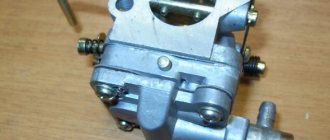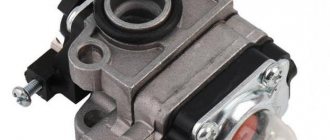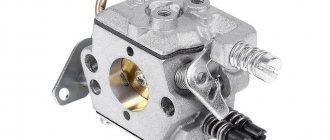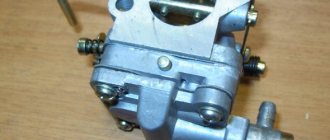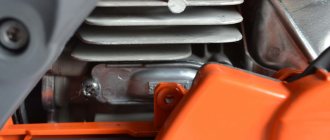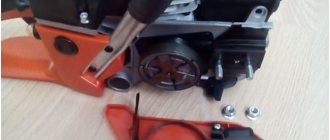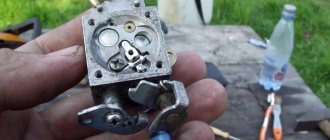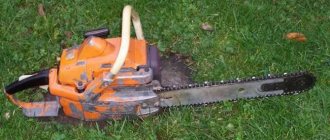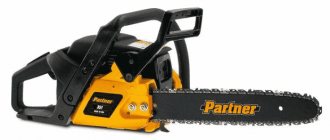Cleaning a chainsaw carburetor any modification, configuration and power follows one traditional and correct scheme, and its need arises as a result of clogging of the part. To understand that it’s time to clean the carburetor, you can observe how the saw starts up and immediately stalls, perhaps still “puffing”, making sounds trying to get the desired speed. One way or another, cleaning the carb with your own hands is quite possible, because our specialists provided instructions and demonstrated a video on how to do it quickly and correctly. Regarding proper cleaning, here we are talking not only about the use of certain products and liquids, but also about the format of purging, putting the carburetor back together, and also checking its readiness for future work.
Sometimes spare parts for a chainsaw do not need repair and cleaning, but timely replacement. Therefore, while your carb can still be cleaned and returned to its original working condition, take the advice from KosiKos and let your mechanism be healthy!
How to clean the carburetor on a chainsaw with your own hands
Before cleaning the carburetor on a chainsaw , let's look at the situations when it needs to be cleaned:
- the saw does not start and stalls;
- the tool does not start;
- The tool stalls when you press the gas.
There are situations when cleaning the carburetor does not help, then you need to replace the repair kit; if after this procedure nothing has changed in the operation of the chainsaw - check the rubber adapter that is located between the cylinder and the carburetor (in its place there may be a rubber adapter with a brass insert). We remove the top cover, filter, long bolts, adapter, disconnect the tubes from the carb and remove it. Direct cleaning process:
- first you need to clean it with a fluffy brush from external dirt and dust so that it does not get inside during disassembly;
- we start with the “H” bolt, which is responsible for the upper working position of the carburetor at maximum speed. We twist it, counting and remembering the number of revolutions, for example, 2.5. Next we unscrew it
- screw in screw “L” while counting the revolutions; it is responsible for low speeds. For example, 4.5 revolutions. We record the indicators and unscrew it;
- remove the top and bottom covers using a screwdriver, unscrewing the bolts. It is better to do this not in a canopy, but on a hard, non-slip surface;
- take out the needle;
- if the gaskets and membranes are very worn out, worn out, they also need to be replaced with new ones, and you can order a carburetor repair kit for Husqvarna, Leader, Shtil or Partner saws in the KosiKosa store;
- often before cleaning you can observe the following picture - in the “sump” and other containers there is a lot of dust and debris;
- We clean the carb by first soaking it in its solvent, then blow it with compressed air using a compressor. We repeat the procedure 2 times. We clean the membranes separately and put them back together. First we put the needle in place;
- We mount the rocker support back onto the needle;
- depress the spring and squeeze out the fixing bolt;
- put the membrane and bottom cover in place and tighten it with bolts (you need to remember or sign which ones secured it);
- We also put the upper membrane with the lid in place and tighten it with bolts;
- place screw “L” all the way, and then unscrew it 4.5 turns, (as an example) as it was on the carburetor, and screw “H” also screw in until it stops and unscrew it the same 2.5 turns (as an example ), maintaining the previous settings. This is necessary in order not to lose settings;
- we return the carburetor to its place in the chainsaw for checking, putting it on the throttle valve;
- the hose coming out of the cylinder is hung on the top, the hose coming out of the tank is on the right side of the carburetor, and the hose that goes for pumping from the primer is on the left - we connect all the hoses to the carburetor;
- insert 2 bolts into the adapter and put it in place;
- close the flap, press the primer several times (10 is enough);
- We are trying to start the instrument.
As you can see, cleaning the carburetor of your tool with your own hands is not at all difficult if you follow the instructions, chronology, fix the maximum and minimum screw speeds, and assemble the unit in exactly the opposite order. The KosiKosa petrol tool store also demonstrates a high-quality video, where all the instructions are clearly supported by a clear example.
Advantages and disadvantages of the popular household chainsaw Partner 350
The Partner brand belongs to a subsidiary of the petrol tool manufacturer Husqvarna. chainsaw is a widely used model that is popular due to its optimal price-quality ratio, high reliability, performance and efficiency.
If the chain is not lubricated
Chain lubrication is important to reduce link friction in the guide bar grooves. To adjust the lubrication system, an oil supply screw is provided. The chain is lubricated only while it is moving. You can check the operation of the oil pump by pointing the toe of the tire towards a light-colored surface. When you press the throttle, oil splashes should appear on the surface.
Carburetor cleaning and everything about it: useful tips
cleaning a chainsaw carburetor is . We have described all the nuances and little things, and now in the summary we will consider other options for breakdown or malfunction of the tool that accompany carb clogging, which also need to be paid attention to:
- failure of the rubber adapter. When it breaks through, the chainsaw shows the same non-working symptoms as with a clogged carburetor. It is located between the cylinder and the carb;
- you can also hear its name as a pipe. In addition to the fact that the carburetor in the saw is clogged, the pipe may rot;
- Cleaning the carb will not be enough; you will have to change the rubber adapter. Our catalog will help you do this easily;
- the fuel filter retainer may be cracked or broken, accordingly, all dirt enters the carburetor;
- the mesh on the crab, which is supposed to clean the gasoline that passes from the tank to the needle, may be clogged;
- do not forget to record the number of revolutions by which the screws “H” and “L” were unscrewed. By correctly returning them to their place, you will save the carburetor settings, but this is a completely different article...
How to clean the muffler
For external cleaning of the outlet, a stiff brush is used, which removes carbon deposits in the usual mechanical way. In case of large deposits inside the muffler, you can choose one of two methods. First: soak the muffler in a chemical composition that removes carbon deposits, then dry it thoroughly. Second: method using a gas burner, first “warm up” the muffler with a burner, then tap on it so that carbon particles fall out of it. All this can be done with either a collapsible or non-dismountable muffler.
The whole procedure does not look very complicated, but we do not recommend performing such repairs yourself without special skills, experience and tools. If a malfunction is detected, it is better to contact the service. Do not forget about the need to observe safety precautions when working with a chainsaw. The muffler gets very hot when the saw is running, there is a risk of burns, so any manipulations with this unit are carried out only when the engine has cooled down.
What can carbon deposits on the muffler indicate?
The rapid appearance of a large amount of carbon deposits can in one way or another characterize the quality of the oil or fuel mixture, as well as the condition of the chainsaw carburetor. A malfunction can be caused by using the wrong engine oil, bad gasoline, or an incorrect fuel mixture ratio. A faulty carburetor and a heavily clogged air filter may also be the cause. If the carbon deposits are oily (greasy), then a mixture rich in gasoline enters the combustion chamber. If it is dry, then on the contrary, there is too much air in the mixture. Of course, if everything is in order with the carburetor and you fill in a good quality fuel mixture, then soot does not appear, or forms in minimal quantities.
Video: chainsaw repair, muffler cleaning
Chainsaw repair at the Straight Hands service center
If you are not sure about the serviceability of the chainsaw and assume that diagnostics or repairs are necessary, contact our service center. We work every day, our clients are residents of St. Petersburg and the Leningrad region. Our company is the official service of Stihl, Husqvarna, Echo, Champion. Here you can order warranty and post-warranty repairs of your chainsaw.
Source of the article: https://zen.yandex.ru/media/ruki24/remont-benzopily-chistka-glushitelia-5c89f788f836be00b4fbe75a
Chainsaw carburetor design
The carburetor of any new chainsaw is an integral part of the engine, which continuously regulates the amount of air required for constant mixing with fuel and supplies the finished mixture to the internal combustion engine cylinder.
In most modern chainsaws, built-in carburetors initially have a similar design and almost the same principle of operation. There are certain differences only in the fuel units of Chinese models.
The main elements of the carburetors of all chainsaws include:
- float chamber - a small compartment whose main task is to maintain the optimal amount of fuel filled;
- atomizer is an important mechanism that is initially responsible for injecting fuel into the intake air flow;
- diffuser - located next to the standard inlet through which air enters the engine compartment of the chainsaw. The main function of the diffuser is to forcefully accelerate the suction of air masses;
- tube - required to supply air in small volumes - portions, the sizes of which depend on the needs of the fuel system.
The operating principle of a chainsaw carburetor is also quite simple.
When the chainsaw is running, the engine throttle valve is activated, which, when open, allows air to flow through the factory rubber tube. With the gradual opening of the standard valve and the tube connected to it, the float located in the chamber with fuel is activated. Continuously passing through a standard diffuser, the air intensively mixes with fuel. After this, the used ready-made air-fuel mixture is sprayed through the factory intake channel into the working cylinder of the standard engine. When spraying fuel, the pressure inside the float chamber of the chainsaw is almost identical to atmospheric pressure. At the same time, the pressure in the factory air tube is rarefied. Due to the difference in these indicators, air is continuously sucked into the tube. As engine speed increases, it requires more fuel. Accordingly, the tube should suck in more air. Thus, the ability of the engine to intensively gain speed required for sawing large wood largely depends on the carburetor.
Why is primary adjustment needed?
During the first hours of operation, the 2-stroke chainsaw engine requires running-in, on which the quality of its further operation depends. During the running-in process, the carburetor is initially adjusted - the optimal parameters for preparing and supplying the fuel mixture are established.
Initial running-in of the chainsaw: working with thin material
Most modern chainsaws are sold adjusted. However, it doesn’t hurt to check the quality of the factory settings - in the end, it’s you who will have to work with the tool.
When starting up for the first time, the chainsaw should operate in a gentle mode. Therefore, for several hours after start, it is recommended not to overload the engine and cut only small branches and trunks up to 10 cm thick.
Simple rules will help you insure against malfunctions of the chainsaw carburetor:
- Always mix gasoline and oil according to the manufacturer's instructions.
Proportions of the fuel mixture for a chainsaw engine
The chainsaw must start correctly, ensure a stable rotation speed of the sprocket and a smooth increase/decrease in power. There should be no extraneous knocks, pops or noises when the engine is running.
Professional hand chainsaw at work
The main thing during the initial running-in of the tool is to ensure that the fuel consumption corresponds to the power used, i.e. in practice, the saw should not go out, “sneeze”, smoke or run jerkily.
How to properly adjust the carburetor on a chainsaw?
In order for self-adjustment of a chainsaw carburetor to bring the desired result, you need to carry out preparatory work. First of all, the operator must ensure that the engine is in good working order. To do this, be sure to remove the top cover of the protective plastic case and carefully inspect the engine cylinder-piston group for burrs, cracks and other defects. If they have formed, the surface of the assembly will need to be sanded. It is important not to damage the protective chrome or nickasil coating of the cylinder.
Next you need to inspect the spark plug. If a thick layer of dried carbon deposits forms on it, the part will need to be unscrewed and thoroughly cleaned. To do this, you need to heat the candle and carefully scrape off any remaining dried oil from its tip.
At the end, you will need to inspect the parts of the entire fuel system of the chainsaw. Clogging in the pipes, accumulated debris in the fuel and air filters, unstable operation of the diffuser - all this leads to the engine losing the required speed. As a result, the operator does not receive accurate information about the operation of the motor and cannot set the correct settings. To prevent this, you need to wash the carburetor parts, filter and tube. After they are completely dry, they can be installed in their original place.
Specifications
This tool belongs to the household class, so the characteristics of the Partner 350 chainsaw mostly correspond to analogues in this class. Main parameters:
- power - 1.44 kW or 1.96 hp;
- tire length - 400 mm;
- chain pitch - 3/8″;
- fuel type - high-octane gasoline oil;
- fuel tank capacity - 0.4 l;
- oil tank capacity - 0.2 l;
- engine volume - 36 cm³;
- noise level - 105 dB;
- tool weight - 4.7 kg.
The chainsaw is characterized by an economical engine, which, thanks to its power reserve, allows the installation of a longer guide bar. The saw has a dual-circuit air cleaning system, and the carburetor is equipped with a manual fuel pump to facilitate starting.
As with all gasoline saws, an emergency chain brake, automatic chain tooth lubrication and a vibration suppression system are available as mandatory options.
On sale you can also find a chainsaw labeled Partner P350S. The main difference is that the S-marked tool is manufactured in China under license from the manufacturer. This saw is characterized by increased engine power to 1.48 kW.
READ DIY saw from a screwdriver
What is responsible for the air supply?
Two dampers installed on the diffuser chamber are responsible for the air supply. The first can regulate the amount of air at the moment you press the accelerator and is called the throttle, and the second ensures that the air supply is limited at the moment when the chainsaw is cold started. To make starting easier, the throttle is closed, which means the mixture becomes rich, as it is saturated with a large amount of fuel. It is easier to work in this mode, but since it increases fuel consumption, this mode is not used throughout the entire operation. The saw is working hard.
To spray fuel into the cylinders, an injector with a check valve is used.
The principle of operation is simple: it limits the return of the mixture back into the chamber. All the main malfunctions of chainsaws most often occur when this mechanism does not work properly.
- The most common mistake is storing the tool for too long. The fact is that with prolonged inactivity, the valve sticks and either fills the cylinder with fuel, or simply does not open.
- The second problem is an increase in the amount of air in the mixture, caused by its suction from the outside due to improper operation of the valve. It is no longer possible to adjust here, since in this case only repairing the valve or replacing it helps, since the saw will not respond to the adjusting screws.
Unlike a car, setting up a chainsaw carburetor provides three adjusting screws that are responsible for the quality of the mixture, quantity and nominal crankshaft speed of the Husqvarna engine:
- screw L – designed to adjust the number of revolutions when operating in medium modes and regulates low speeds;
- Screw H – adjusts the number of high speeds and thrust of the installation;
- T – is designed to adjust the total amount of fuel and adjusts the operation of the throttle assembly.
It is not recommended to touch the first two screws without special skills. The problem is that if you configure them incorrectly, the carburetor will not be able to start the engine, or even start it in the wrong operating modes. Such adjustment of the screw can lead to its rapid wear and failure. This principle is embedded in many devices.
No table provides the settings parameters. Therefore, you should not look for this data in specialized literature, but just strictly follow the instructions. The table in the passport has only informational value regarding the characteristics of the engine.
Do-it-yourself chainsaw carburetor adjustment
To independently adjust a standard carburetor, the chainsaw owner will need a Phillips or flathead screwdriver, as well as a manual tachometer.
To adjust the carburetor of a chainsaw, spring-loaded adjusting screws are provided in the basic structure of the carburetor.
Depending on the brand of chain saw, the markings of its adjustment screws may vary. However, in order to initially correctly configure the carburetor on a chainsaw, you can always follow the same algorithm:
- First, the operator must look in the saw's instruction manual for the exact incremental angles for turning the spring-loaded adjustment screws. Immediately after this, on the saw in use with the engine turned off, they must be turned according to the instructions in the manual. Failure to do this may result in the operator breaking the tool's motor;
- Next, the chainsaw used on the farm will need to be placed motionless on a flat, stable surface. In this case, the bar and factory chain must initially be directed away from the operator;
- Then you need to start the internal combustion engine of the saw and give it at least 10 minutes to warm up;
- After this, you need to find the correct position of the screw L. To do this, the operator must slowly turn it along and counterclockwise until the motor runs quietly and without failures;
- If as a result of this the chain begins to rotate, then it is necessary to find the position of the screw T at which the chain will stop in place:
- Next, you will need to connect a tachometer to the internal combustion engine cylinder. Then you need to start turning screw H. As soon as the readings on the tachometer match the instructions in the saw instructions, the screw can be released.
When flushing the carburetor is no longer worthwhile
Flushing the carburetor with your own hands is the easiest way to restore the functionality of the device. However, it does not always allow you to fix various types of breakdowns. To make sure that the device really needs cleaning, and washing will help restore the functionality of the mechanism, you will need to disassemble it.
If after disassembly some factors are discovered in the form of corrosive deposits (oxidation of aluminum), as well as the formation of warping in the carburetor channels, then ordinary washing will not help here. You can use the washing procedure in a special ultrasonic bath, but even in this case the chances of restoring functionality do not exceed 50%-60%.
Drawing a conclusion, it should be noted that the need and possibility of cleaning the carburetor can only be assessed after disassembling it. Here it should immediately be noted that the carburetor cleaning procedure can be performed in two ways:
- Automatic - washing is carried out in a special ultrasonic bath. Features of the procedure are discussed below.
- Manual - this method is not always suitable, but involves cleaning the channels of the mechanism using a special carburetor cleaner. This method is only suitable in cases where there is no deformation of the carburetor channels. If the process of corrosion or warping has begun in the channels, then, depending on the complexity of the process, only washing in an ultrasonic bath can help, but not always
Buying an ultrasonic bath specifically for cleaning a chainsaw carburetor is simply irrational. That is why in this material we will consider the manual washing procedure. We will also learn from this material what cleaning with an ultrasonic bath is.
This is interesting!
Regularly blowing out the carburetor with a compressor will not do anything, so don’t console yourself with the thought that now I’m blowing out the channels and the chainsaw will work like new.
How to flush a chainsaw carburetor?
You should think about cleaning the fuel unit of a power tool in the following cases:
- when it is difficult to start the engine;
- in case of unstable operation of the internal combustion engine at short-term idle speed;
- in case of failures when smoothly pressing the standard throttle trigger;
- with a significant increase in fuel consumption.
Most often, liquids that are found in almost every garage are used to flush the built-in carburetor of a chainsaw:
- kerosene;
- diesel fuel;
- pure gasoline;
- solvent.
Modern gardeners using powerful professional saws use more effective and gentle means:
- Mannol Vergaser Reiniger is a cleaner marketed in aerosol form. It quickly and easily breaks down even the oldest formations of resins, soot, oily deposits and other types of contaminants;
- Hi-Gear – This cleaner is distinguished by its high dissolution properties. It can remove old dried stains, oily crusts and the first signs of rust without harming the parts of the fuel system;
- Jet 100 Ultra is a high-tech spray designed to quickly clean the carburetor of a chainsaw. Shows a high rate of dissolution of the oldest oil stains.
Cleaning the carburetor on a chainsaw is performed in the following sequence:
- First you need to clean the outer part of the saw engine, and also remove and thoroughly rinse the factory air filter housing;
- Next, you can proceed to disassembling the power tool. To do this, you need to remove the filter housing and also unscrew the fasteners holding the carburetor together with the engine;
- Then you will need to carefully disconnect the thrust and gas cables from the carburetor. The springs included in the design must be removed so as not to stretch them;
- After this, you need to carefully pull off the fuel supply hoses from the factory fittings of the fuel unit;
- To clean the carburetor on a chainsaw, you need to remove it from the original mounting pins. At the same time, it is important to maintain the integrity of the gasket installed between the internal combustion engine cylinder and the fuel unit;
- The next step is to clean the outer walls of the carburetor. To do this, they can be treated with liquid cleaner or gasoline. In this case, you need to try to prevent dust and debris from getting inside the engine assembly or cylinder;
- Next, you will need to unscrew the screws securing the carburetor diaphragm, remove its cover and wash the internal cavity with an aerosol cleaner;
- After this, you need to dismantle the fuel pre-fine filter, and also disassemble the part of the assembly to which the fuel is supplied. All internal parts of the carburetor must be thoroughly washed with an aerosol cleaner. If the first cleaning does not bring results, then the washing should be repeated.
After all the internal parts of the standard carburetor have completely dried, you need to assemble the fuel unit in the reverse order and install it in place in the structure of the household chainsaw.
Cleaning correctly
To properly clean your chainsaw, you will need the following tools:
- Phillips and flat screwdriver,
- wrenches with heads of different sizes,
- special cleaning composition, cleaning cloth,
- ultrasonic cleaner.
The set of tools can be seen in the photo.
Cleaning the carburetor of a chainsaw should be done according to the following algorithm:
- First you need to drain the remaining fuel from the fuel tank. Remove the cover of the chainsaw by unscrewing the fasteners. We take out the filter and disassemble the housing, removing nuts and clamps if necessary.
- Remove the fuel mixture supply hose from its clamp, unscrew the fasteners of the carburetor top cover. How to clean the carburetor of a stihl ms 180 14 chainsaw? And adjusting the chainsaw carburetor. Then remove the top cover and the blue gasket - this is the fuel pump membrane. The chainsaw must correctly recognize malfunctions in the chainsaw's carburetor. To the left of the body there are spring clips, remove them, and then the screws. It is advisable to label the parts and schematically record the places from which they were removed, so as not to confuse anything during assembly.
- Remove the bottom carburetor cover, unscrew the screw and remove the needle valve and the spring under it. Repairing a Husqvarna 137 chainsaw, what goes into the carburetor is how to remove the sprocket from. Then, using longitudinal force, remove the air damper and its axis.
- Remove the throttle valve, drive lever and throttle shaft.
- We lay out all the removed carburetor parts on a flat surface and inspect them to ensure integrity is maintained. Carburetor of the Husqvarna 142 chainsaw. Parts with a high degree of wear must be replaced with new ones.
- Using a specialized cleaning agent, wash the parts and dry with a lint-free cloth. The tubes must be blown under pressure using a pump.
- To achieve maximum effect, you can clean the carburetor on a Shtil chainsaw using a special cleaning bath, the basis of which is the cavitation effect. The bath is filled with diesel fuel, and the carburetor parts are immersed in it for several minutes. Finally, we dry the parts using a pump.
- Author: Maria Sukhorukikh
Rate this article:
- 5
- 4
- 3
- 2
- 1
(0 votes, average: 0 out of 5)
Share with your friends!
Gasoline does not enter the chainsaw carburetor - repair methods
Most often, the standard cause of this common breakdown is the formation of a blockage in the fuel foam filter or tubes responsible for the stable supply of fuel to the factory metal cylinder of the engine. Every third Chinese power tool regularly suffers from these blockages. This is due to the low quality of the built-in filters and tubes that come with inexpensive Chinese chainsaws.
Repairing a fault involves removing and washing contaminated parts.
To do this you need:
- Remove the cover of the plastic saw body;
- Clear the space underneath and begin dismantling the hoses and filters. The tubes are attached to the outlet fittings using clamps. To disconnect the hoses without damaging them, you need to loosen and remove the clamps. After this, the tubes will need to be blown out with compressed air and washed with clean gasoline;
- To dismantle the filter, you must first remove it from the factory housing. After this, the element will need to be placed in a container with clean gasoline. After a day, the filter can be removed and given time to dry;
- After washing, all parts must be carefully installed and secured in their original place in the carburetor.
This cleaning regimen will help thoroughly flush the most vulnerable elements of the fuel system without having to disassemble the entire carburetor.
The reason why the Husqvarna 142 chainsaw does not start
If the Husqvarna 142 chainsaw does not start, there may be several circumstances. The most common ones include the following:
- Damage to spark plugs - to determine whether a spark plug is working properly, you need to unscrew it and inspect it. In this case, if the porcelain insulator has cracked, you see a burnt or warped electrode, you should immediately change the spark plug. In addition, after working for several seasons, the Husqvarna 142 chainsaw requires inspection of spare parts. Spark plugs also develop their own resource, and to ensure the safety of the saw, replace them with new ones.
- Carburetor clogged - during operation, fuel vapors evenly settle on the internal walls, forming a sticky consistency that can clog the carburetor, preventing the engine from starting. You will need to clean it with a special detergent. When repairing a Husqvarna 142 chainsaw, carburetor adjustment is always carried out with a warm engine and cleaned systems.
- Malfunction of the ignition coil - before you decide to replace this part, make sure that the spark plugs meet the required technical condition.
Why does a chainsaw shoot into the carburetor?
The main reason for this malfunction is an incorrectly set distance between the ignition elements of a gas-powered tool. Because of this, the fuel that enters the standard cylinder of the internal combustion engine does not have time to completely burn in it. The result is a sound similar to an explosion. To effectively solve the problem, you need to set the ignition of the gas-powered tool, following the instructions in the user manual.
Often, this type of chainsaw carburetor malfunction is the result of a fuel mixture that is lean or too rich in oxygen entering the cylinder. To eliminate the breakdown, you need to adjust the operation of the metal throttle valve and the standard jets of the fuel unit.
Fuel supply system repair
Fuel may not enter the cylinder for the following reasons:
- Fuel filter is dirty. You should remove the fuel hose and check how the fuel flows. If the stream is weak, the filter may need to be cleaned. It is taken out through the filler hole of the fuel tank and cleaned; in case of severe contamination, it is replaced with a new one. As a preventative measure, it is recommended to replace the fuel filter once every three months.
- Clogged breather (hole in the fuel tank cap). They also check by disconnecting the hose; if clogged, clean it with a needle.
- Lack or insufficient fuel. There may be several reasons for the malfunction. The first reason is a clogged air filter. Air stops flowing into the carburetor in the required quantity, and therefore, due to the fuel mixture being too rich, engine operation is disrupted. The dirty filter is carefully removed, cleaned and rinsed in water, then dried and replaced.
Another reason is incorrect carburetor adjustment. Adjustment is made with three screws.
Timely replacement of the fuel filter guarantees a complete fuel supply
The fuel hose and choke actuator must fit tightly to the fittings
The throttle cable must be in place.
During work, you must use the instructions, otherwise you can only make things worse.
And the last reason is a violation of the integrity of the membrane or clogging of the carburetor channels.
All parts must be clean, dry and in good working order.
Calm 250 chainsaw malfunction (carburetor chainsaw malfunction):
Immediately after winding, the chainsaw runs at increased speed, and if you press the gas, instead of starting to accelerate, it “chokes” and even stops. Or it starts poorly, does not rev up, and does not stall (this chainsaw problem applies to other expensive chainsaws with an accelerator pump in the carburetor).
Cause of chainsaw failure: Wear of the rubber cuff on the accelerator pump piston in the carburetor (fuel accelerator). This leads to air being sucked in by the accelerating pump, and the main jet injects a lean fuel-air mixture (mixed with a small amount of gasoline) into the diffuser, and the chainsaw first operates at increased speeds, and then “throttles” and nods. This occurs after 2-3 years of use and usually occurs during the hot summer months.
Related Posts
How to completely clean a chainsaw: carburetor, filter, muffler
When operating a tool such as a chainsaw, its owner often faces a number of problems, one of which is a clogged carburetor. How to clean a chainsaw filter - youtube. This can happen if the chainsaw is filled with low-quality gasoline or foreign debris gets into the fuel tank. Like another tool, a chainsaw carburetor. Husqvarna 137 chainsaw repair. In order to clean the carburetor of a chainsaw, you must first disassemble it.
Carburetor chain malfunction
Remove the carburetor from the chainsaw. Remove the fuel pump cover using the diaphragm by unscrewing one screw in the center of the cover. Then turn the carburetor towards you using the throttle body, on the side where there are two holes, one pin is visible, there is an accelerator pump underneath it. Remove the retaining ring from the outside of the pin and disconnect the wire spring choke. Unscrew the screw in the center of the throttle body, remember how the throttle is installed (and then put it down) and remove the throttle. Pin hole (the accelerator is spring loaded and if you pull the throttle shaft out and don't close the hole the accelerator will pop up), then rotate the throttle shaft and remove it. Shake the accelerator (piston) out of the hole with a spring. There is a rubber seal (ring) on the piston. its wear is what causes the chainsaw to malfunction. rubber cuff and spring (they are sold as a repair kit). Or you can remove the worn piston with spring and plug the hole by hammering in a rubber plug (the chainsaw will be without an accelerating pump, i.e. it will not accelerate for 3 seconds, but for 4 seconds, but it will work well because it will not intake air carburetor).
Assembly after repairing a chainsaw malfunction (after removing a carburetor chainsaw malfunction) is performed in the reverse order of disassembly. When assembling the throttle body, before screwing in the screw, the throttle body must be properly positioned so that it does not stick, and screw the throttle body screw onto the axle, degrease and spread with a special thread sealant (sold in small pipes, red, liquid) or pliers because, If this bolt comes out during operation, it goes directly into the cylinder) and repair or replacement of the piston cannot be avoided). Therefore, we looked at troubleshooting this chainsaw problem.
Solutions
If there is carbon deposits inside, then there are two ways, which mainly depend on whether the muffler is collapsible or not.
If the muffler of your chainsaw is dismountable, then the most suitable way is mechanical. Disassemble the muffler into its component parts and clean with a wire brush. After removing the base layer, you can sand it with fine sandpaper and wash it with chemicals. Let the parts dry and put them back together.
If the muffler is not dismountable, the situation is somewhat more complicated. In this case, it is impossible to get to all possible places where soot has accumulated. There are many different recommendations - from soaking in acetone to pouring shot inside.... The most effective is still the use of special technical detergents, such as SKAT-D, Kavisan-Carbon S, Nanotek TK-1 and others... How to use them? We simply soak the muffler in the product for several hours and then blow it out with a compressor. However, as far as possible, carbon deposits must be removed mechanically, since deposits in the muffler can be so “cemented” that no SMS will completely remove them.
Cleaning your chainsaw muffler is one of the steps to properly care for your chainsaw.
It would seem, why does a summer resident who grows vegetables and fruits, or the owner of a country house with a small garden and several flower beds, need a chainsaw? The question disappears when the desire arises to build a bathhouse, update a greenhouse, knock down an old business, or simply make a bench for relaxation. Unfortunately, any mechanism periodically needs maintenance and replacement of spare parts, and for this you need to have a good understanding of the structure of the product, besides, repairing a chainsaw with your own hands will save time and money.

